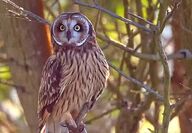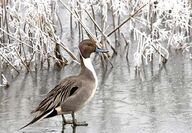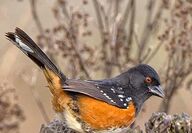Sorted by date Results 51 - 75 of 77

The Common Yellowthroat [Geothlypis trichas] is a warbler that inhabits many environs, from low swamps to 6,000-foot-elevation streams. Its “witchity, witchity, witchity” call can be heard all along Central Oregon rivers. One of the first warblers to arrive in spring, it behaves in a wren-like fashion as it flits about through low vegetation. The male displays to the female during courtship by flicking wings and tail, following her closely, and performing a flight dis... Full story

The smallest falcon, the Merlin (Falco columbarius), primarily hunts smaller birds while flying — flushing birds from thickets and chasing them using their amazing speed and maneuverability to catch their prey on the wing. During their breeding season the Merlin inhabits open upland and lowland prairies. Merlins do not build their own nests; instead they use old stick nests built by hawks, magpies or crows. Occasionally they nest on ledges or tree cavities. The nest... Full story

Quickly moving rivers and streams are home to the Common Merganser (Mergus merganser). Cruising jet-like up and down waterways, only a few inches above the ripples, landing and then diving for fish and crustaceans with their serrated bills, this Merganser sports either a vivid rust-colored crest (female) or a iridescent green head (male) that is a joy to behold. The Common Merganser nests in hollowed-out trees, on cliffs or on the ground, normally on the banks of rivers.... Full story

As one walks around meadows and open backyards, you are likely to hear a blurry sound “pee-wee, pee-wee,” often followed by a “pip, pip”. This is the call of a Western Wood Pee-wee (contopus sordidulus). This gray nondescript flycatcher will perch on the end of a branch and quickly dart out and catch insects in the air and a small clap-clap sound is made when capturing the bugs or when protecting the nest area. In late spring a nest is built by the female in the fork of an a... Full story

The Green-tailed Towhee [pipilo chlorurus], with its distinctive rust crest, is a somewhat secretive ground-nesting bird. On occasion a Towhee uses porcupine hair to line its nest, where it lays four to six pale blue, heavily spotted eggs which hatch in 11 to 14 days. The chicks will begin foraging in 11 to 14 days. This Towhee will protect its nest by raising its tail and skittering off mimicking a ground squirrel to distract predators. As a ground forager, it spends most of... Full story

Bullock’s Orioles (Icterus bullock) breed in riparian and open woodlands and favor areas where the trees are large and spaced well apart or in isolated clumps. They often nest in sycamores, cottonwoods, willows, and deciduous oaks. They eat insects and other arthropods, as well as fruit and nectar. They glean insects from leaves, branches and trunks; they also pluck insects from spider webs or from the air, and take ripe fruit from bushes and trees. Bullock’s Orioles use a m... Full story

The canyon wren [Catherpes mexicanus] is a small wren found in arid, rocky habitats from southern British Columbia throughout the western United States and Mexico. The canyon wren is visually inconspicuous but easily detected during the breeding season by its loud, distinctive song, often heard throughout canyonlands of western North America. Few terrestrial birds are as restricted to rocky cliffs or outcrops as this one. It inhabits the same territories year-round, commonly... Full story

Orange-crowned warblers (Oreothlypis celata) are beginning to arrive and their trill can be heard in the underbrush along streams and lakes. One of the plainest of warblers, the orange feathers on its head are almost never visible. This species is also among the most hardy. They are usually seen singly, sometimes loosely associated with flocks of other birds. In all seasons they tend to stay fairly low, in bushes or small trees, flicking their tails frequently as they search... Full story

The sora (Porzana carolina) is the most common and widely distributed rail in North America. It is sometimes also referred to as the sora rail or sora crake. Although shot in large numbers every year, their high reproductive rate enables them to maintain a stable population. A variety of calls are made, including ker-wee or sor-ee, wheep, and quink-quink-quink. The song is a loud, descending, nasal whinny. Like other rails, it is easily heard in marsh habitat but difficult to... Full story

The mountain quail (Oreortyx pictus) is the largest quail in the United States. I found these colourful quail on the shoulders of Mt. Jefferson, and while waiting for a good opportunity to capture an image from my truck, had one sitting on a log staring at me and he did not blink for 40 minutes. In foothills and mountains of the far west, coveys of these striking birds scurry through the manzanita thickets. Mountain quail are often overlooked, because they keep to dense cover;... Full story

A familiar resident of our ponderosa pine forests is the white-headed woodpecker (Picoides albolarvatus). Feeding on insects, cone seeds, and larva from the thick bark of ponderosa pines, they also nest in older snags of pines. After excavating the nest cavity, two to nine white eggs are laid and the parents share brooding duties for approximately 14 days, and then the chicks are fed by both parents for another 26 days in the nest. At least some of the pairs remain together... Full story

The wild turkey (Meleagris Gallopavo) is not a native species in Oregon. Introduced in 1961 by ODFW, they are now well established in the pine forests around the Metolius Basin. The subspecies Rio Grande has had the most successful natural expansion, although the Merriam’s also has a steady population. Females lay 10-14 beige mottled eggs which hatch in approximately 28 days, and within 24 hours of hatching the poults have left the nest. Insects, berries, seeds and all v... Full story

In many areas of western North America, the melodious song of the black-headed grosbeak (Pheucticus melanocephalus) is a familiar harbinger of spring. They appear here in May with both male and female singing from tops of trees. Their song is often confused with the robins’ morning symphony. They are feeding heavily now in preparation for their long migration to Central America and Baja. Their nests are so thinly constructed that eggs can be seen through the bottom. Thin n... Full story

The prairie falcon (Falco mexicanus) breeds from southern British Columbia south to north-central Mexico and western Texas. It spends its winters within its breeding range, including Central Oregon and farther east into the Great Plains states. Their preferred habitats include dry plains, sagebrush, desolate mountains and prairies. Prairie falcons in summer eat mostly small mammals, particularly ground squirrels. They also eat pikas, birds, and insects. During courtship, the... Full story

The chipping sparrow [Spizella passerina] frequents roadsides, bird feeders, mountain meadows and grassy fields across the west. The male guards the female as she builds a rather flimsy nest that often can be seen through and provides little insulation for its young. After 3-4 days of building, 2-7 pale blue to white, lightly streaked eggs are incubated for 10-15 days. During the breeding season the female develops a bare patch on her abdomen that fills with fluid. This... Full story

The echoing fluted melody within the forests now is the hermit thrush (Cartharus guttatus). A mostly rust-brown bird of the forest floor that builds its nest from pine needles, grass, and wood bark held together with mud and lichen and lined with willow catkins. Three to six light-blue eggs hatch in 11 to 13 days, and the chicks leave the nest in 10 to 15 days after being fed wasps, beetles, ants and caterpillars gleaned from under leaves on the forest floor. Walt Whitman... Full story

The short-eared owl [Asio flammeus] is a medium-sized owl with relatively long wings and tiny, often-concealed ear-tufts. In Latin, the word flammeus means fiery, flaming, or the color of fire. Generally nocturnal, but often active 30 to 60 minutes before sunset; some owls may be active during the day during the breeding season. Short-eared owls eat mainly small mammals, but sometimes take birds. Meadow voles are the primary prey. Deer mice, shrews, ground squirrel and pocket... Full story

The nasal call coming from high in the pines as the flock moves though the forest are pinyon jays (Gymnorhinus cyanocephalus). The pinyon jay is a permanent resident of the pinyon-juniper woodlands and ponderosa pines forest. With bills adapted to extract seeds from cones, they will cache thousands of seeds which will be used in the winter months. Their hairless nostrils allow them to grab the seeds without getting sticky sap on themselves. They also consume many insects,... Full story

As the season begins to take on its winter cloak, tiny twitters can be heard high in our forests. Most likely these songs are the communal sounds of the golden-crowned kinglet (Regulas satrapa). A tiny warbler-sized bird weighing in at four to eight grams and three to four inches long, they are able to withstand temperatures down to -40º F. They build their nest within a spruce, fir, cottonwood or hemlock forest up to 60 feet high where they raise two broods. The male... Full story

The animated and enthusiastic behaviors of the Western kingbird (tyrannas verticalis), are easily seen in open areas throughout the west. Their buzzes and snapping wings are heard as they defend their nesting territories and fly-catch from open perches. Arriving in April from a winter in Central America, they choose their nesting site and both the male and female defend their territory. The male has an impressive courting display as he twists and turns upward to 60 feet and... Full story

The cedar waxwing [bombycilla cedrorum] occurs in medium to large flocks that will be seen on almost any tree that has berries. Serviceberry, dogwood, honeysuckle and mistletoe are just a few fruiting plants that provide food. In winter they consume cedar berries, hence their name "cedar" waxwing. Waxwing refers to the red waxy secretions that appears on their secondary feathers, which may help in attracting a mate. Cedar waxwings are among the latest nesting birds. The... Full story

In early spring the symphonious melodies of the male American robin (Turdus Migratorius) are heard over the entire U.S. They begin mating in April and can produce up three broods by the end of July. The female builds the cup-shaped nest with grass, twigs, and feathers and a coating of mud for stability. Occasionally the male will assist in the gathering of materials. The nest is built in many places including drainpipes, in wreaths on doors, window ledges, and of course... Full story

The northern pintail is a relatively common dabbler duck feeding on grains, seeds, crustaceans and aquatic insects. It gets its name from the long tail feathers ending in a distinctive narrow sharp tip. They begin nesting in very early spring, laying 6-12 pale olive eggs which hatch in 21-25 days. Ducklings leave the nest immediately and are capable of flying in 38-45 days. Pintails once were one of the most abundant ducks in North America but have suffered a disturbing... Full story

The spotted towhee [Piplio Maculatus] is a common bird of the thickets and blackberry brambles. Often seen under bird feeders eating seeds off the ground but never far from cover. They feed mostly on insects, berries, and seeds scratched from leaf litter. In April the female builds the nest using soft grasses, twigs, and animal hair. While she finishes the nest the male spotted towhee spends up to 90 percent of his mornings singing territorial songs. Three to six pale creamy... Full story

The great horned owl [Bobo Virginianus] is our most common owl. A nocturnal hunter, they hunt silently, gliding over fields and woodlands in search of mostly small mammals. However, great horned owls will also prey on other owls, hawks, snakes and young alligators. Over 250 prey species have been identified. Great horned owls begin their mating behavior of hooting, screeching, bowing and rubbing beaks in December. They begin nesting in January with the building of a large... Full story